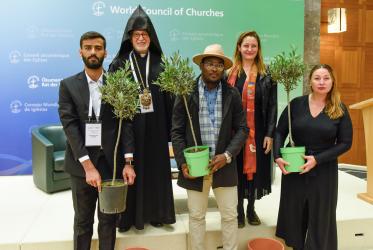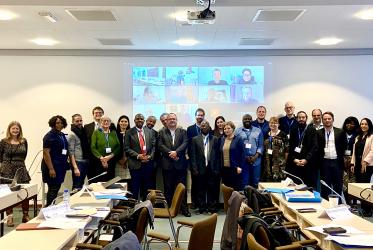The days after the Ascension are a time of waiting and expectation, a time like the earliest disciples in Jerusalem in which to reflect on the meaning both of Jesus’ life and its significance for ourselves: indeed a season of both pain and glory. That is certainly the experience these days of our brothers and sisters in those lands where Christianity first began.
I have always enjoyed Ascensiontide in the church’s calendar, and I am glad that here in Switzerland and in France we mark it properly, with a public holiday. When my husband Alan and I were on the staff of Westcott House theological college in Cambridge, training men and women for the priesthood, Ascension Day used to be the liturgical highlight of our year, marked by a Eucharist held, weather permitting, in the late afternoon outdoors in Westcott’s delightful garden, a feast of sumptuous liturgy followed by a fairly sumptuous buffet.
In those days a particularly striking touch to mark the end of the Eucharist was the ignition of four firework rockets one from each corner of the garden, to symbolise the ascension of Jesus. Those rockets of considerable size and power were an essential part of the proceedings, even though some of us had mental questionmarks about the wisdom of this way of reinforcing the vertical imagery of the Ascension.
As the lecturer in liturgy and worship Alan had the task each year of organising suitable ordinands to take charge of setting off the rockets safely. One particular year Alan thought he was on to a winner. The ordinand he chose for the role had served in an army. His military expertise would surely stand him in good stead.
However, as two of the rockets decided to take off horizontally rather than vertically we began to understand why the student in question might have thought that a change of career from militant to spiritual was advisable. One of the horizontal rockets plunged safely into the wooded area of the garden where there was no one around. But the other headed in the direction towards where I and a number of others were standing playing our recorders.
As we scattered in all directions, I think we surprised ourselves by how fast we could run to get out of the way. But afterwards as I was recovering my breath it seemed to me that it was a wonderful parable of what the Ascension was ultimately about. As the angels told those first disciples, no longer were we supposed to stay gazing up into heaven: rather we were being scattered with power to be engaged in God’s mission horizontally throughout the earth.
The great Anglican Archbishop William Temple caught this when he said, ‘In the days of Jesus’ earthly ministry, only those could speak to him who came where He was. If He was in Galilee, men could not find Him in Jerusalem; if He was in Jerusalem, men could not find Him in Galilee. But His Ascension means that He is perfectly united with God; we are with Him wherever we are present to God; and that is everywhere and always.”
So there is a profound connection between Jesus’ Ascension, and his final words to his disciples which sound like both promise and challenge, ‘You will be my witnesses in Jerusalem, in all Judaea and Samaria, and to the ends of the earth.’
And the rest of the Book of Acts shares with us just how those words are fulfilled through the adventures of the disciples. Well, at least in part. Because one of the things about Acts is that it is actually quite selective in the story it tells.
For the story Luke, the writer of Acts, is really interested in telling us is how the Christian faith travelled from Jerusalem via the great city of Antioch in Syria, on through Ephesus, to Athens, and then eventually to Rome, in New Testament times seen as the great capital of the world.
In Luke’s mind certainly these later travels are primarily linked to the work and travels of Paul. Yet Luke also gives us little hints that the story was more complicated and intricate than this.
For example he nowhere tells us how exactly the Christian faith first arrived in the city of Damascus in Syria, but it must have got there somehow at a very early time, because it was while he was on his way to persecute the believers in this city that Paul had his own Damascus Road experience. And it is this alternative story, that story that Luke doesn’t really share with us, that is part of the history and reality of Christians in the Middle East.
For even though the Book of Acts does not tell us about it, we know that the road ran East as well as West from Antioch, and that before the end of the first Christian century there were substantial Christian communities in the Tigris-Euphrates valley, the lands that we now call Iraq and Syria. We know too that the road also ran south as well as north from Jerusalem itself, and within ten or twenty years of the earthly life of Jesus there were many Christians living in Alexandria and north Africa.
Their descendants have kept the faith often in difficult times and places through the twenty centuries that separate us from the days of the New Testament. Since the lens through which many of us look at church history has been partly constructed for us by Luke’s portrait in the Book of Acts, all too often the story or even the existence of these long enduring Christian groups in the Middle East is unknown to the western Christian world.
Nothing infuriates a Middle East Christian more than being asked by a polite but naïve European or North American whether it was his parents or grandparents who first professed the Christian faith as a result of western missionary work.
The pain and the glory. I don’t know what you think of when you hear the word ‘glory’? I guess the picture in my mind’s eye tends to be things like sparkly Christmas tinsel, and kings and queens on thrones, and singing Christmas carols in which you somehow make the word ‘Gloria’ string out over about 50 notes. There’s quite a lot of glory in that sense around in Ascensiontide as we reflect on the kingship and the triumph and the victory of Christ. Perhaps even a bit too much for some of us. But let us dig a bit deeper.
The Hebrew word for glory is kabod. Its three key letters, k b d, come from a Hebrew root whose fundamental meaning is ‘heavy’. Strangely the human organ, the liver, has the same three letters, because it is the heaviest organ in the body. And you find that people’s baggage and possessions are sometimes described as their kabodim, what gives them weight and makes them important. And from this you get round to glory being a word which is used to describe someone’s visible presence.
So when we talk about the glory of God we are speaking of what makes God visibly present to us. And in most of the Bible the language of God’s glory is indeed linked to metaphors which speak of overwhelming power and strength. But not in the Gospel of John, and most particularly not in the bit of the Gospel of John which we have just heard read as our Gospel, as Jesus prays to his Father ‘glorify your Son’.
For from the beginning of his story, as John speaks of how ‘the Word became flesh and dwelt among us, and we have seen his glory’, this Gospel is wonderfully subverting the traditional understandings of glory. For now, John is telling us, the visible presence of God can be seen not in thunder and lightning but in the human life of Jesus Christ. From the face of Jesus God’s visible presence shines out into our world.
And then as we weave our way through this Gospel, picking up the clues that the evangelist offers here and there to tantalise us, we discover something even more strange and contradictory. For the moment when Jesus will be ‘glorified’ – when the visible presence of God will be perceived in him most clearly - comes not at a moment of power but at a time of apparent supreme weakness, as he is exalted and lifted up to hang on his Cross.
That is the stark and startling message of the Gospel of John. It has turned upside down those traditional understandings of glory. It is in and through Jesus’ death that the Father will answer the prayer Jesus is making here, and glorify his Son.
And then I invite you to look further down the reading we have just heard, and discover how Jesus then goes on to promise that he will be glorified also in his disciples, those whom God has given to him. They too are being offered the privilege of being living signs of a God whose essential nature, which is love, makes him supremely vulnerable. That is our own vocation, but sometimes we need the help and experience of others to have it made clear to us.
The pain and the glory. The photograph above was taken at a refugee camp for Christians in the Kurdistan area of northern Iraq during a visit made there in January by the World Council of Churches of which I was privileged to be part. The shining face of the baby at the centre of the picture somehow speaks to me of God’s glory, of God somehow visibly present in this vulnerable human child and the family and people to whom he belongs.
There are different kinds of ecumenism, of Christians being drawn together to witness to their common faith. There is the ecumenism of theological dialogue, and there is also the ecumenism of common and shared work and endeavour. But today, given the sufferings of our fellow Christians in many parts of the world, but especially at the moment in the Middle East, I recall how Pope Francis has spoken also of the ecumenism of blood and the ecumenism of martyrdom.
The pain and the glory of our suffering fellow Christians in such lands as Iraq, and Syria and Egypt can draw us closer into the mystery of what it means to be joined together in the One Body of the Ascended Christ.





